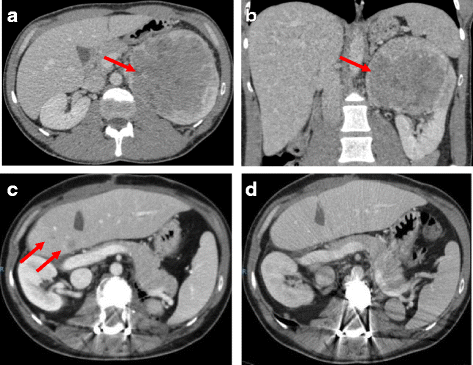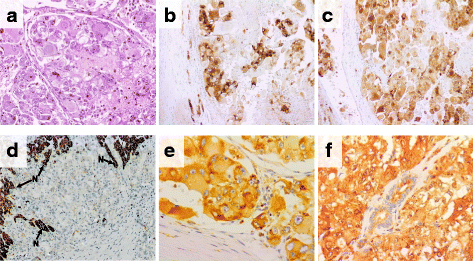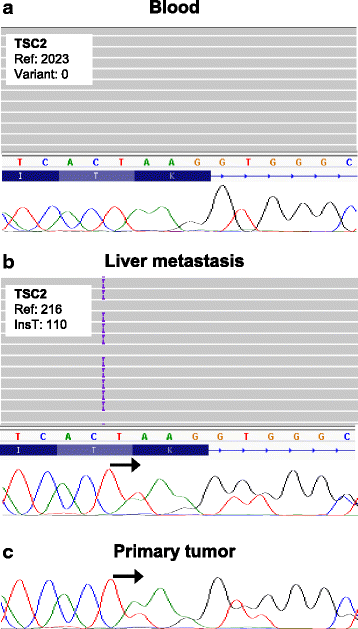Advanced sporadic renal epithelioid angiomyolipoma: case report of an extraordinary response to sirolimus linked to TSC2 mutation
- PMID: 29764404
- PMCID: PMC5952422
- DOI: 10.1186/s12885-018-4467-6
Advanced sporadic renal epithelioid angiomyolipoma: case report of an extraordinary response to sirolimus linked to TSC2 mutation
Abstract
Background: Renal epithelioid angiomyolipomas (EAML) are rare tumors with aggressive behavior. EAML can be sporadic or develop within the tuberous sclerosis complex syndrome, where mutations of TSC1 or TSC2 genes (critical negative regulators of mTOR Complex 1) result in an increased activation of mTOR pathway. Optimal EAML treatment, including mTOR inhibitors, remains undetermined.
Case presentation: Here we present the case of a young adult with a renal EAML that after radical nephrectomy developed metastases, first in liver and then in lumbar vertebrae. After complete surgical resection of these lesions, liver recurrence was detected, this time with incomplete surgical resection. After finding a new liver lesion, systemic treatment with sirolimus started. The patient exhibited a complete and durable response to this drug, being disease free at the time of publication, after 36 months of treatment. Targeted next generation sequencing (NGS) of MTOR, TSC1 and TSC2 genes in the primary tumor, metastasis and blood of the patient, revealed one inactivating TSC2 mutation (c.2739dup; p.K914*) in the tumor cells. Immunohistochemistry revealed decreased TSC2 protein content and increased phospho-S6 in the tumor cells, demonstrating mTOR pathway activation.
Conclusion: NGS on an EAML patient with an extraordinary response to sirolimus uncovered TSC2 inactivation as the mechanism for the response. This study supports NGS as a useful tool to identify patients sensitive to mTOR inhibitors and supports the treatment of malignant EAML with these drugs.
Keywords: Renal epithelioid angiomyolipoma; Sirolimus; TSC2 mutation; mTOR pathway activation.
Conflict of interest statement
Ethics approval and consent to participate
The study was approved by the Hospital Institutional Review Board of the Hospital Universitario Virgen del Rocío (reference number 33140027), and the patient provided written informed consent to participate in the study.
Consent for publication
We obtained written informed consent of the patient for the publication of the case report and accompanying images.
Competing interests
The authors declare that they have no competing interests.
Publisher’s Note
Springer Nature remains neutral with regard to jurisdictional claims in published maps and institutional affiliations.
Figures



Similar articles
-
Clinical presentations and molecular studies of invasive renal epithelioid angiomyolipoma.Int Urol Nephrol. 2017 Sep;49(9):1527-1536. doi: 10.1007/s11255-017-1629-4. Epub 2017 May 25. Int Urol Nephrol. 2017. PMID: 28547571
-
Constant allelic alteration on chromosome 16p (TSC2 gene) in perivascular epithelioid cell tumour (PEComa): genetic evidence for the relationship of PEComa with angiomyolipoma.J Pathol. 2008 Feb;214(3):387-93. doi: 10.1002/path.2289. J Pathol. 2008. PMID: 18085521
-
Mutation in TSC2 and activation of mammalian target of rapamycin signalling pathway in renal angiomyolipoma.Lancet. 2003 Apr 19;361(9366):1348-9. doi: 10.1016/S0140-6736(03)13044-9. Lancet. 2003. PMID: 12711473
-
Treatment of renal angiomyolipoma in tuberous sclerosis complex (TSC) patients.Pediatr Nephrol. 2017 Jul;32(7):1137-1144. doi: 10.1007/s00467-016-3474-6. Epub 2016 Sep 1. Pediatr Nephrol. 2017. PMID: 27585680 Review.
-
Differentiating the mTOR inhibitors everolimus and sirolimus in the treatment of tuberous sclerosis complex.Neuro Oncol. 2015 Dec;17(12):1550-9. doi: 10.1093/neuonc/nov152. Epub 2015 Aug 19. Neuro Oncol. 2015. PMID: 26289591 Free PMC article. Review.
Cited by
-
Partial nephrectomy can be a successful treatment option for renal epithelioid angiomyolipoma: a case report and literature review.Acta Med Litu. 2020;27(1):33-38. doi: 10.6001/actamedica.v27i1.4264. Acta Med Litu. 2020. PMID: 32577094 Free PMC article.
-
Acute haemorrhage from a large renal epithelioid angiomyolipoma: diagnostic and management considerations in a teenage patient with a rare cancer.BMJ Case Rep. 2023 May 18;16(5):e252351. doi: 10.1136/bcr-2022-252351. BMJ Case Rep. 2023. PMID: 37202109
-
Clinical challenges and management of primary renal epithelioid angiomyolipoma of duplex kidney with paraneoplastic syndrome.J Int Med Res. 2021 Jul;49(7):3000605211032493. doi: 10.1177/03000605211032493. J Int Med Res. 2021. PMID: 34325570 Free PMC article.
-
Malignancy of renal angiomyolipoma from tuberous sclerosis complex with TSC2 mutation.Chin Med J (Engl). 2019 Jan 5;132(1):103-105. doi: 10.1097/CM9.0000000000000026. Chin Med J (Engl). 2019. PMID: 30628968 Free PMC article. No abstract available.
-
Huge renal epithelioid angiomyolipoma - A case report of a giant, benign renal mass.Int J Surg Case Rep. 2020;66:374-378. doi: 10.1016/j.ijscr.2019.12.032. Epub 2019 Dec 28. Int J Surg Case Rep. 2020. PMID: 31945544 Free PMC article.
References
Publication types
MeSH terms
Substances
Grants and funding
LinkOut - more resources
Full Text Sources
Other Literature Sources
Medical
Miscellaneous

